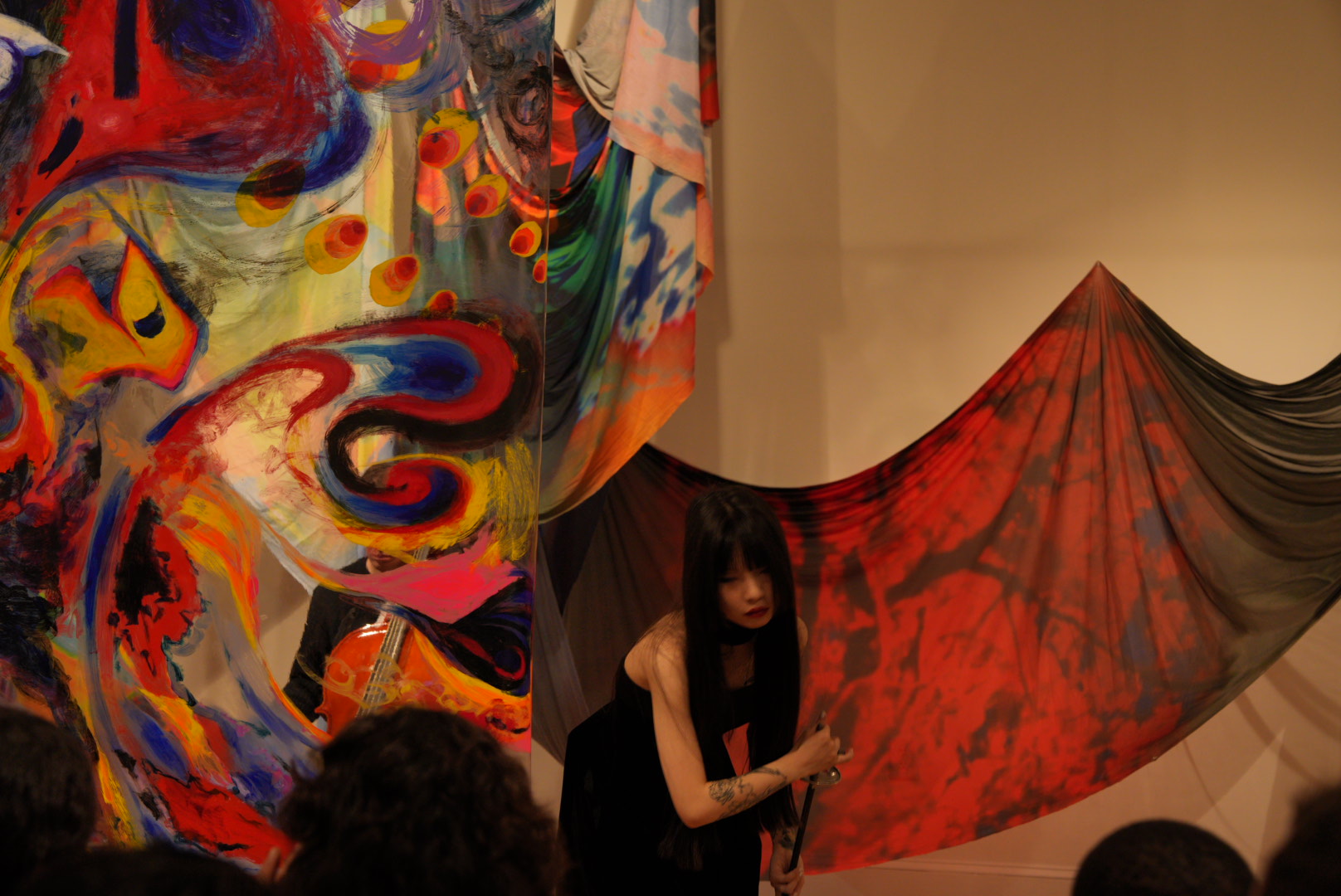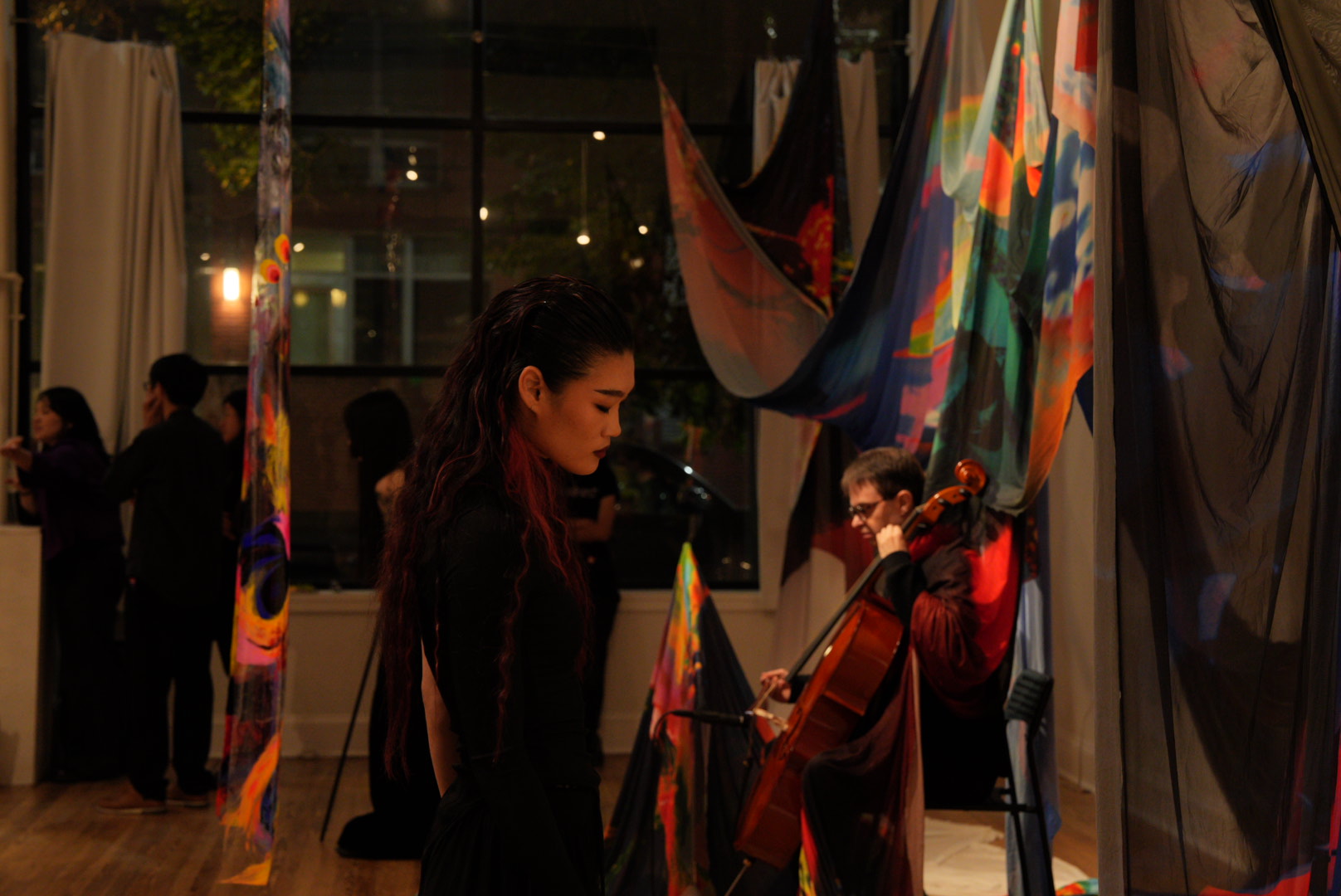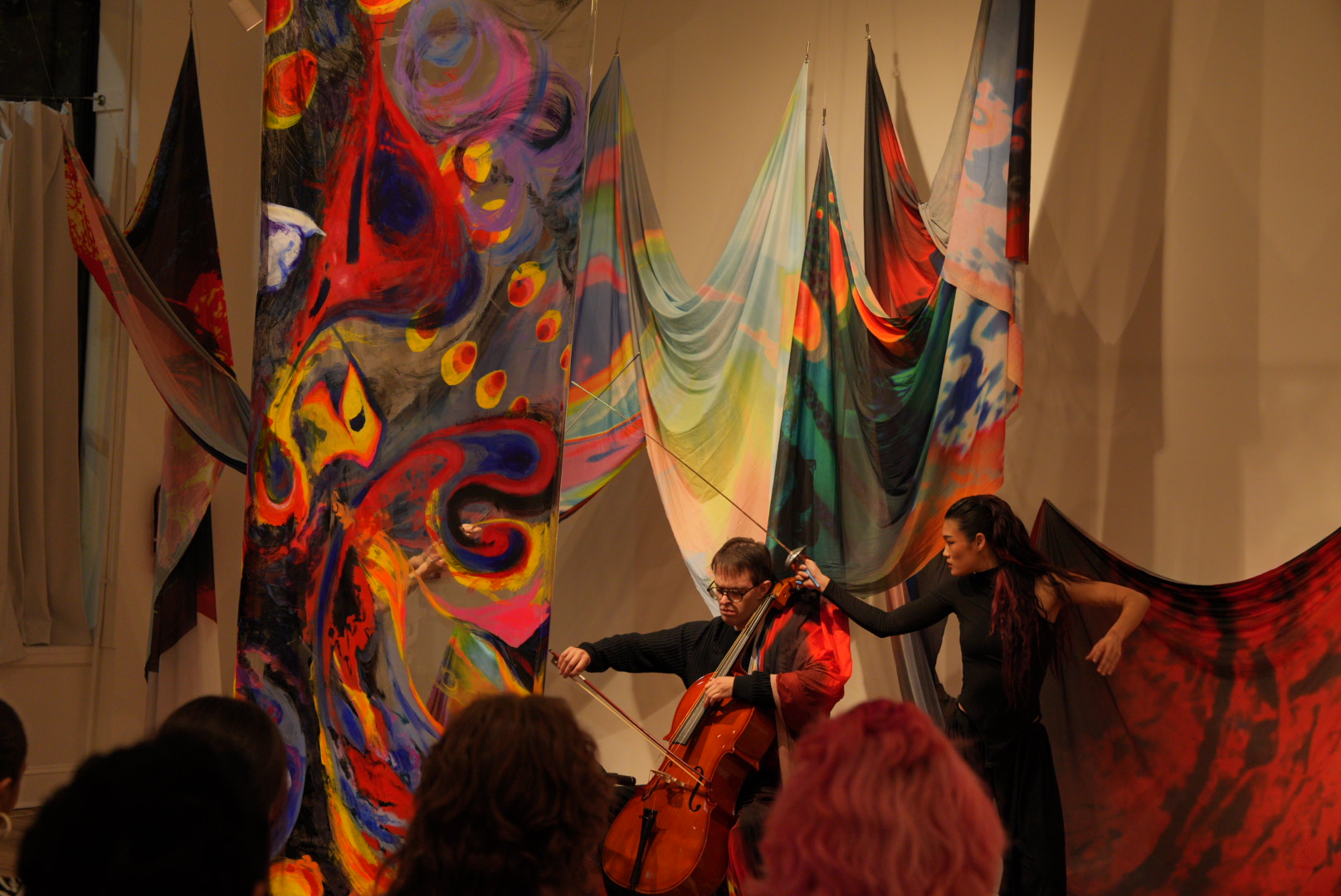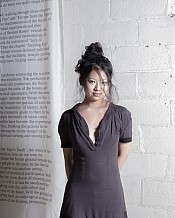Whitehot Magazine
October 2025
"The Best Art In The World"
"The Best Art In The World"
October 2025
While the Mantis Hunts the Cicada: Performance “Résistance” by Lucia Shuyu Li & Young-Jun Lee
 Artist Lucia Shuyu Li and Cellist Robert Karpay during performance “Résistance” at Making Space Baltimore, 2025. Photo courtesy of Qin Ai Xin.
Artist Lucia Shuyu Li and Cellist Robert Karpay during performance “Résistance” at Making Space Baltimore, 2025. Photo courtesy of Qin Ai Xin.
By RUI JIANG October 18, 2025
First, we say the composition—the arrangement of compose, music, and perform—is a will that wavers between empowerment and coercion. Broken syllables and uneven footsteps probe one another, test one another, lie in ambush, then flee in panic, then flare into madness. The collaboration Résistance between performance artist Lucia Shuyu Li and composer Young-Jun Lee wrings out a force that seeps and infects, streaming beneath the dome Li has wrapped in her fierce canvas, from which relational turns surge forth.
No one dares to move. Her body begins circling with that of Robert Karpay, the cello performer. Li, fully armed, peers through the holes of her mask, measuring danger with the sword in her hand; Karpay, sly and acute, draws and retracts his bow with noiseless poise, carrying a faint warmth of composure and the curving, inescapable languor you already sense—he moans, concentrates, surveying the field like a guard. You cannot tell whether he is the lurking threat or merely Li’s echoing shadow. No one dares to move. The audience holds their breath, afraid to startle the scene and make an enemy of it, afraid to be dragged beneath the dome shimmering with phosphorescent flicker.
 Artist Lucia Shuyu Li, Performer Ceci Sun, and Cellist Robert Karpay during performance “Résistance” at Making Space Baltimore, 2025. Photo courtesy of Qin Ai Xin.
Artist Lucia Shuyu Li, Performer Ceci Sun, and Cellist Robert Karpay during performance “Résistance” at Making Space Baltimore, 2025. Photo courtesy of Qin Ai Xin.
After a while, finally, another body emerges around Li. Likewise, she holds a sword, creating sounds, measuring the periphery. Until the two perceive each other—then the cello abruptly shifts, sawing out tense and capricious strings, the sound of breath and friction—probing, hiding, striking—boiling like oil; sharp as a blade; hot as fire. Sword against sword, their scraping erupts again and again, a chain of shrill cracks reverberates, followed by a sudden, thunderous thud that shakes the heart. The sword repeatedly pierces the canvas; the dome quivers; cruelty flickers, half-visible, in the colors of the cloth. One is at a loss—uncertain whether it is the dome Li has constructed that is collapsing, or if the entire performance intends to rip open a fissure toward that other world, to witness its withering and decay.
Li and Lee’s conspiracy molds, through embodied adhesion and shared chant, a compassionate yet deformed fetus—an arrangement that betrays, deceives, and entangles, where clarity and illusion rot into a single muddy ground. The murky continuum of history seems, for a moment, to form a pure structure: the ambush within the fight, the cold revelation of the present’s naked truth. Yet—from performance artist and composer, to cellist, to the sudden incursion of co-performer Ceci Sun—these multiple infiltrations, interferences, and entanglements are constantly woven beneath the unknowable glimmer and flickering acoustics of the piece. The mandala-world they construct, when it finally falls, tears apart the silence domesticated by violence. It seeks to veil the sky, ruthless yet half-concealed, and heaven and earth themselves shimmer uncertainly within it.
 Artist Lucia Shuyu Li, Performer Ceci Sun, and Cellist Robert Karpay during performance “Résistance” at Making Space Baltimore, 2025. Photo courtesy of Qin Ai Xin.
Artist Lucia Shuyu Li, Performer Ceci Sun, and Cellist Robert Karpay during performance “Résistance” at Making Space Baltimore, 2025. Photo courtesy of Qin Ai Xin.
This celestial mother-body—the divided, devoured carcass Li has exiled outward—begins to shed itself. The seemingly harmless purity of history’s structure disintegrates; what stands exposed, undeniable, is the passivity of all actions: the shrill cries of the individual are subordinated to the collective, the collective’s grandeur subdued by the collective unconscious, and the latter, wild and running, accuses and betrays, as if convinced that no one can escape from heaven and earth.
Between the poetic nakedness and the absolute violence lies a chasm—no longer a transitive realism, but an intransitive dissonance. It circles around the shadowed core of violence, the ornate yet vulgar desire beneath. In the end, it flows toward the viewer, contagious through their shared breath-holding, trembling yet intact, borne by unease, exposed beneath the blazing sky. WM

Rui Jiang
Rui Jiang is a Baltimore-based independent curator and writer. She holds a Master's degree in Curatorial Practice from Maryland Institute College of Art. Her research moves between semiotics, intimate gestures, and shifting dialogues, examining how art forms deconstruct and reconstruct within a polycentric field. She investigates the tensions embedded in exhibition-making—complicity, reflexivity, and the shifting power dynamics that shape artistic discourse. Through interdisciplinary approaches, she experiments with curatorial strategies that challenge linear narratives, embrace contradictions, and reimagine the relationships between artists, audiences, and institutions.
view all articles from this author








